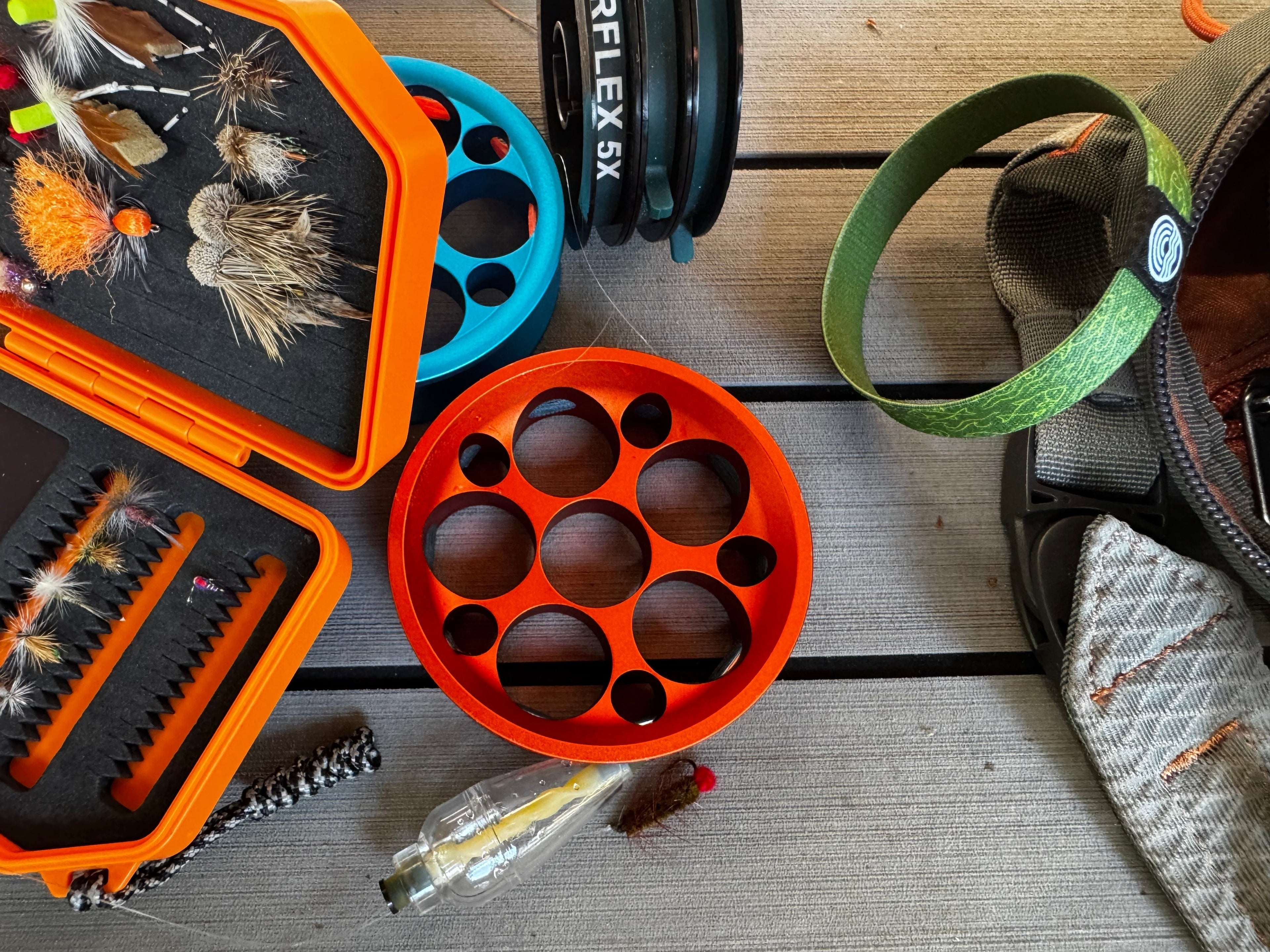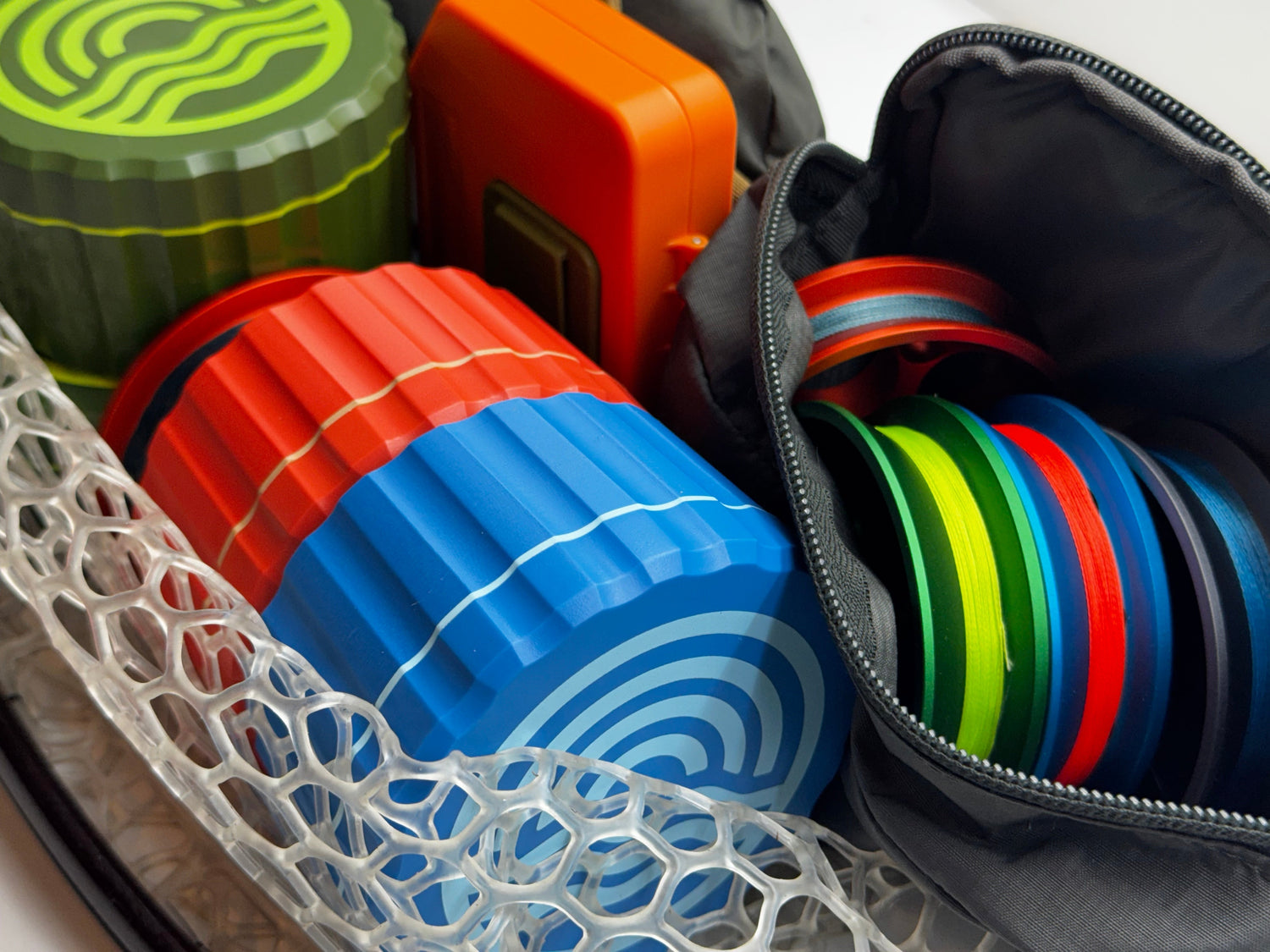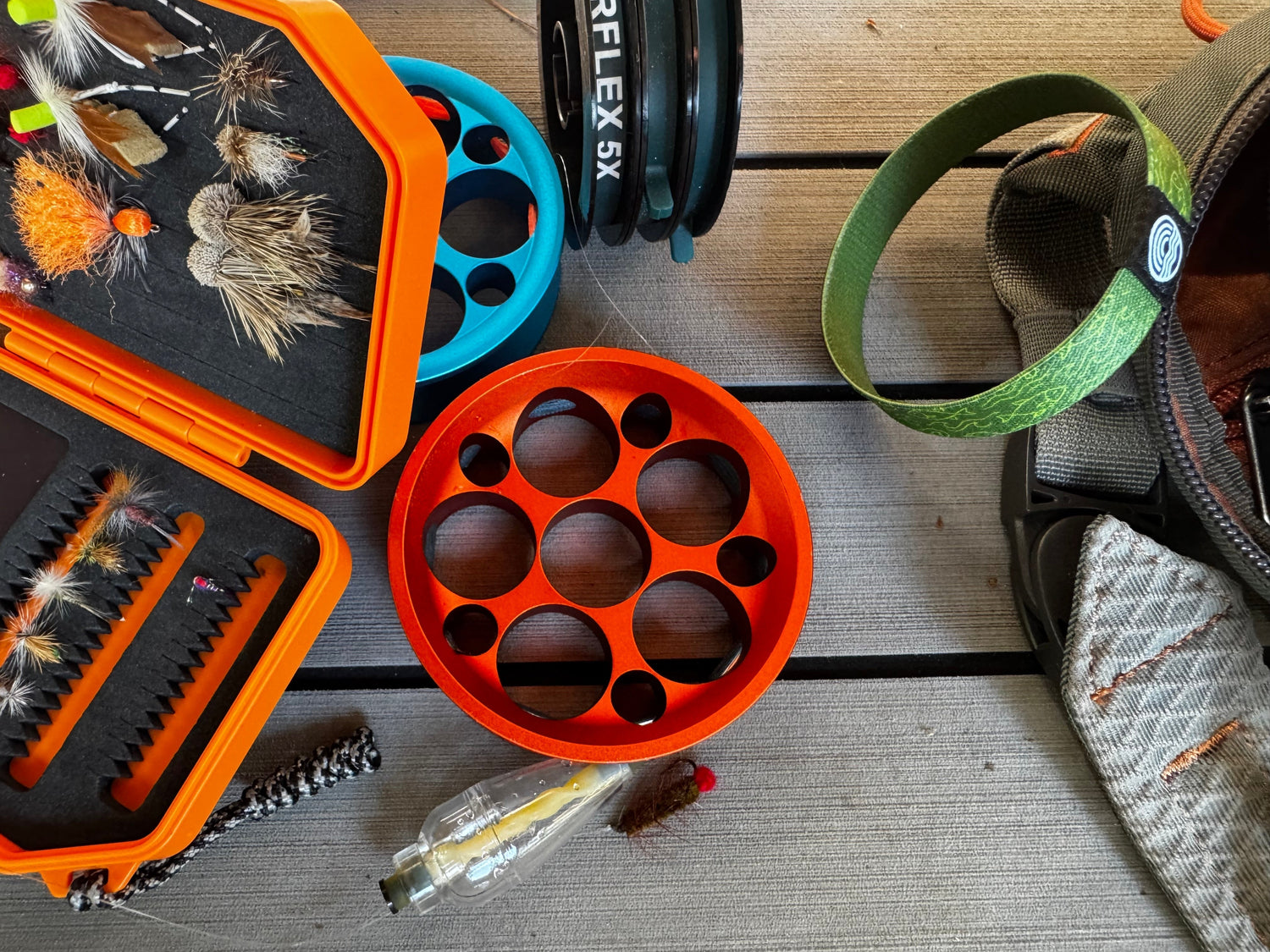What is Fly Fishing with a Hand Reel?

Fly fishing with a hand reel changes everything you thought you knew about getting flies to fish. No fly rod required. No complicated casting technique to master. Just you, your GoReel, an a-just-a-bubble float, and access to every trout stream in Western North Carolina.
Here's the beautiful part: hand reel fly fishing combines the effectiveness of fly patterns with the portability of pocket-sized gear. Your entire setup – reel, line, flies, and bubble float – fits in your pocket. That hidden creek you spotted on your last hike? Now it's fishable. The high-elevation stream that's a three-mile trek from the nearest parking spot? Pack light and go.
Why Fly Fish with a Hand Reel Instead of Traditional Fly Fishing Gear?
Traditional fly fishing is fantastic. (We're not here to knock what works.) But let's talk about what hand reel fly fishing offers that might change your adventures.
Portability wins every time. Your GoReel Pro weighs less than two ounces. Add an a-just-a-bubble and a few flies, and you're still under half a pound for your complete fishing setup. Compare that to hauling a fly rod, reel, waders, and vest into the backcountry.
Zero setup time. No rigging, no assembling rod sections, no threading line through guides. You're fishing within thirty seconds of arriving at the water. We've timed it. (Repeatedly. In multiple locations. We may have a problem.)
Works in tight quarters. Those rhododendron-choked WNC streams where there's barely room to breathe, let alone make a backcast? Perfect for hand reel fishing. The brush that grabs fly rods? Not an issue when you're making compact, controlled casts.
The learning curve is refreshingly gentle. If you can skip a stone, you can cast a hand reel. The backhand toss motion feels natural from day one, unlike fly casting which can take weeks or months to master.
The A-Just-A-Bubble Technique: Your Secret Weapon

The a-just-a-bubble float is what makes fly fishing with a hand reel work so well. This clear, partially-fillable bubble serves as your casting weight and strike indicator rolled into one elegant solution.
Here's how it works:
Fill it partially with water – usually about one-third to half full. This gives you the weight needed to cast your fly out to feeding fish while keeping the bubble transparent enough that fish don't spook.
Attach your fly – typically 18 to 36 inches behind the bubble on a leader. Adjust this distance based on water depth and how deep you want your fly to drift.
Cast with your standard backhand toss – the bubble provides just enough weight to carry your fly to the target. The motion is identical to your regular hand reel casting technique.
Watch for strikes – the bubble acts as your visual indicator. When it dips, twitches, or disappears, set the hook.
The real genius? You can adjust your presentation on the water. Add more water to cast farther or into wind. Remove water for delicate presentations in calm conditions. Change flies in seconds without re-rigging anything complicated.
Best Flies for Hand Reel Fishing in Western North Carolina

WNC trout aren't particularly picky when you're presenting flies naturally, but certain patterns consistently produce in our mountain streams.
Dry Flies That Deliver
Elk Hair Caddis (sizes 14-18) – This pattern mimics the abundant caddisflies hatching on WNC streams from April through October. The buoyant elk hair keeps it floating even in choppy pocket water.
Parachute Adams (sizes 14-18) – The universal attractor pattern. If you're carrying just one dry fly into the backcountry, make it this one. Visible in all light conditions, and trout hit it consistently.
Stimulator (sizes 10-14) – Larger profile for aggressive fish or low-light conditions. Great for the Davidson River, West Fork Pigeon, and other productive WNC waters.
Nymphs for Subsurface Success
Pheasant Tail Nymph (sizes 14-18) – Imitates mayfly nymphs, which trout feed on year-round. Add a small split shot 12 inches above the fly if you need to get deeper.
Copper John (sizes 14-18) – The weight in this fly helps it sink quickly in faster water. Perfect for pocket water fishing in streams like the Nantahala or Tuckasegee.
Zebra Midge (sizes 18-22) – Don't overlook these tiny patterns. On tailwaters like the Delayed Harvest sections, midges can be the only thing working during winter months.
Streamers for Aggressive Fish
Woolly Bugger (sizes 6-10) – Strip this through deeper pools for larger, predatory trout. Black, olive, and brown all produce in WNC waters.
Clouser Minnow (sizes 6-10) – Excellent for smallmouth bass in the French Broad River or lake-run fish in Fontana.
Where to Fly Fish with a Hand Reel in Western North Carolina
Western North Carolina offers some of the finest trout fishing in the eastern United States. With your GoReel, you're no longer limited to easily-accessible sections.
Great Smoky Mountains National Park

Deep Creek – Park at the Deep Creek Campground and hike upstream. The farther you go, the fewer anglers you'll encounter. Your hand reel lets you access sections where there's barely room to walk, let alone cast a fly rod.
Hazel Creek – Requires a boat shuttle across Fontana Lake, then hiking in. The backcountry sections hold wild brookies that rarely see anglers. Pack light with your GoReel and enjoy the solitude.
Cataloochee Creek – Drive to the Cataloochee Valley early, then hike upstream past the crowds. Native brook trout in crystalline water, surrounded by old-growth forest.
Pisgah National Forest

Davidson River – The Delayed Harvest section sees heavy pressure, but hike upstream into the trophy section. In the upper reaches, you'll find wild rainbows and browns that test your skills.
West Fork Pigeon River – Park at the Forest Service road and hike to the upper sections. Gorgeous pocket water perfect for hand reel techniques.
North Mills River – Less crowded than the Davidson, with excellent wild trout populations. The compact casting required here plays perfectly to hand reel strengths.
Urban and Accessible Waters

French Broad River (Asheville sections) – Don't overlook the smallmouth bass fishing literally running through downtown Asheville. Your GoReel fits in a backpack for a lunch break fishing session.
Lake James – The clarity here makes the a-just-a-bubble technique deadly effective for suspended bass. Fish the creek channels and rocky points.
Mills River near the Hatchery – Delayed Harvest water that's perfect for practicing your hand reel fly fishing technique close to civilization.
Step-by-Step: Setting Up Your Hand Reel for Fly Fishing

Getting rigged for hand reel fly fishing takes about sixty seconds once you've done it a couple times. Here's the complete setup:
Step 1: Start with your GoReel or GoReel Pro Load it with 50-75 yards of 6-10 pound monofilament. We prefer 8-pound for most WNC trout fishing – strong enough for larger fish, light enough for natural presentations.
Step 2: Attach your a-just-a-bubble Thread your main line through the bubble's tube. Secure it with a barrel swivel – this prevents line twist and gives you a solid connection point for your leader.
Step 3: Add your leader Tie 18-36 inches of fluorocarbon leader to the swivel. For most situations, 4-6 pound fluorocarbon works well. Go lighter (2-3 pound) in clear, low water or for highly pressured fish.
Step 4: Tie on your fly Use an improved clinch knot or your preferred fly fishing knot. Keep it simple and reliable.
Step 5: Partially fill the bubble Add just enough water for your casting distance. Start with one-third full and adjust from there.
Total weight of this complete setup? Under four ounces. Total space in your pack? Less than a water bottle.
Casting Techniques for Hand Reel Fly Fishing

The backhand toss you already know from regular hand reel fishing works perfectly for fly fishing. The bubble provides the weight, while the fly trails behind naturally.
The Standard Cast
Position yourself with your target about 30-45 degrees off your casting-hand side. Swing your GoReel back smoothly, then accelerate forward with a fluid motion. Release at the point where your arm is about 45 degrees from vertical. The bubble pulls the line out, and your fly settles behind it naturally.
Adjusting for Distance
Longer casts – Add more water to the bubble and extend your backswing slightly. The increased weight lets you reach farther with the same casting motion.
Shorter, delicate casts – Remove water from the bubble and focus on a soft, controlled release. This works beautifully for spooky fish in clear water.
Working Tight Spots
Here's where hand reel fly fishing really shines in WNC's brush-choked streams. Instead of worrying about backcasts catching trees, you're making compact, controlled tosses into pocket water. Flip casts work great – a short, upward flick that drops your fly into feeding lanes with minimal line on the water.
Reading Water and Presenting Flies with a Hand Reel
Fly fishing with a hand reel doesn't change where fish live – it just changes how you reach them.
Target the same water you would with traditional fly fishing. Seams between fast and slow current, the heads and tails of pools, undercut banks, behind boulders, beneath overhanging branches. Trout still need shelter, oxygen, and food delivery.
Vary your retrieve based on the fly pattern. With dry flies, let them drift naturally – the bubble keeps them floating while your fly looks like a natural insect. With nymphs, add occasional twitches to imitate movement. With streamers, strip line in short bursts to trigger predatory strikes.
The direct feedback advantage. Without a fly rod dampening every sensation, you feel strikes immediately through your hand reel. That subtle take that might go unnoticed with traditional gear? Crystal clear with your GoReel.
Seasons and Hatches in Western North Carolina
Hand reel fly fishing works year-round in WNC, but knowing what's hatching helps you choose the right flies.
Spring (March-May)

Blue-winged Olives, Quill Gordons, and Hendricksons hatch throughout this period. Water temperatures climb, and trout become increasingly active. This is prime time for dry fly fishing with your hand reel.
Summer (June-August)

Caddisflies dominate WNC streams during summer. Terrestrials – ants, beetles, grasshoppers – become important as the season progresses. Early mornings and evenings fish best during heat waves.
Fall (September-November)

The best dry fly fishing of the year happens in WNC during fall. Trout feed aggressively before winter, and hatches can be prolific. Pack your GoReel for leaf-peeping hikes and fish the streams while you're out there.
Winter (December-February)

Midges and small nymphs produce when nothing else will. Focus on Delayed Harvest sections and slower water. The portable nature of hand reel fishing means you can check multiple spots quickly without committing to a full day of traditional fly fishing.
Advanced Techniques: Multi-Fly Rigs
Once you're comfortable with single-fly presentations, try adding a dropper fly. Here's how:
Tie your lead fly (usually a dry fly or bubble) to your leader as normal. From the bend of that hook, attach 12-18 inches of tippet. Tie your dropper fly (typically a nymph) to the end of this tippet.
This setup lets you fish two depths simultaneously. The dry fly or bubble acts as a strike indicator for the subsurface nymph. When fish are feeding at multiple levels, this technique absolutely produces.
What to Pack for a Hand Reel Fly Fishing Adventure

The beauty of hand reel fly fishing is how little you need to bring. Here's a complete setup that fits in cargo pants pockets:
- GoReel or GoReel Pro with line
- 2-3 a-just-a-bubble floats (they're inexpensive and occasionally get lost to snags)
- Small fly box with 10-15 assorted patterns
- Spool of 4-6 pound fluorocarbon leader material
- Hemostats or forceps for hook removal
- Fishing license (required in all WNC waters)
- Polarized sunglasses for seeing fish and protecting your eyes
Optional additions if you have pocket space:
- Small split shot container for weighted nymph fishing
- Floatant for dry flies
- Strike indicators if you prefer them over the bubble
- Tippet rings for quick leader changes
Total weight? Under half a pound. Total volume? Fits in two pockets.
Regulations and Ethics for WNC Waters
Different sections of WNC streams have different regulations. Always check current rules before fishing.
Delayed Harvest Waters – Catch and release only during the DH season (typically October through early June). These sections are stocked and provide excellent opportunities to practice hand reel fly fishing techniques.
Wild Trout Waters – Natural reproduction occurs here. Many sections are catch and release year-round. These are the crown jewels of WNC fishing.
Hatchery Supported Waters – Harvest is typically allowed. Check creel limits and size restrictions.
Great Smoky Mountains National Park – Special regulations apply. Most streams are catch and release for brook trout. Rainbow and brown trout have specific seasons and limits.
Practice leave-no-trace principles. Pack out everything you pack in. Avoid trampling stream banks. Release fish carefully and quickly if you're practicing catch and release.
Common Questions About Hand Reel Fly Fishing
Can you really catch trout on flies with a hand reel? Absolutely. The fish don't care how your fly arrived – they care about whether it looks like food. The a-just-a-bubble technique presents flies naturally and effectively.
Is it harder than regular fly fishing? Actually, most people find the learning curve easier. The backhand toss feels intuitive, while traditional fly casting takes significant practice to master.
What size fish can you handle with a hand reel? We've landed everything from 6-inch wild brookies to 20+ inch browns with GoReels. Your line and leader determine what you can handle more than the reel itself.
Does the bubble spook fish? The clear, partially-filled bubble sits far enough from the fly that it rarely causes issues. In extremely clear, low water conditions, you might want a lighter presentation – but that's true of any fishing method.
Why Hand Reel Fly Fishing Works So Well in WNC

Western North Carolina's geography and fishing opportunities align perfectly with hand reel advantages.
The terrain is challenging. Steep gradients, heavy brush, and limited trail access characterize the best WNC fishing. Hand reel fishing turns these obstacles into non-issues.
The best fishing requires hiking. Your GoReel weighs less than a granola bar. Traditional fly fishing gear weighs pounds and takes up significant pack space. More miles covered means more water fished.
Opportunistic adventures happen here. You're hiking to a waterfall and spot rising trout. You're camping and hear fish splashing at dusk. With your GoReel in your pocket, these moments become fishing opportunities instead of "wish I'd brought my rod" regrets.
The fish don't care about tradition. Wild WNC trout eat flies presented naturally, whether they arrived via $800 fly rod or $40 hand reel. We've tested this extensively. The trout remain consistently unimpressed by our gear choices.
Getting Started with Hand Reel Fly Fishing Today
Ready to try fly fishing with a hand reel? Here's your actionable plan:
Week 1: Get your gear together. Order your GoReel or GoReel Pro, pick up a few a-just-a-bubble floats at any tackle shop, and grab a basic selection of flies (Parachute Adams, Elk Hair Caddis, Pheasant Tail Nymph, Copper John, Woolly Bugger in sizes 14-16).
Week 2: Practice in your backyard or local park. Set up your rig and practice the backhand toss. Focus on smooth, controlled casts. Accuracy matters more than distance.
Week 3: Hit easier water first. Start with accessible streams where you can build confidence. The Davidson River Delayed Harvest section or Mills River near the hatchery both offer great learning opportunities.
Week 4: Venture into the backcountry. Now that you've got the technique down, explore those hidden WNC streams you've been eyeing. The ones where traditional fly fishing gear would be a burden.
The Freedom of Packable Fly Fishing
Fly fishing with a hand reel isn't about replacing what you love – it's about adding possibilities. Traditional fly fishing has its place and its beauty. But when you want to fish that hidden creek, when you're backpacking and want to bring fishing along, when the brush is too thick for backcasts, when you value every ounce in your pack – hand reel fly fishing opens doors.
In Western North Carolina's magnificent waters, those doors lead to adventures most anglers never experience. The high-elevation brook trout streams that require three-mile approaches. The rhododendron tunnels where only hand reel fishing works. The spontaneous evening sessions when you're already hiking and spot rising fish.
Your GoReel fits in your pocket. Your flies and bubble float fit in the other pocket. Every hike becomes a potential fishing trip. Every WNC stream becomes accessible.
That's not just convenient – that's fishing freedom.
Ready to experience fly fishing with a hand reel for yourself? Explore our GoReel and GoReel Pro options designed specifically for packable fishing adventures. Simple gear. Endless WNC adventures. Fishing that fits in your pocket.






